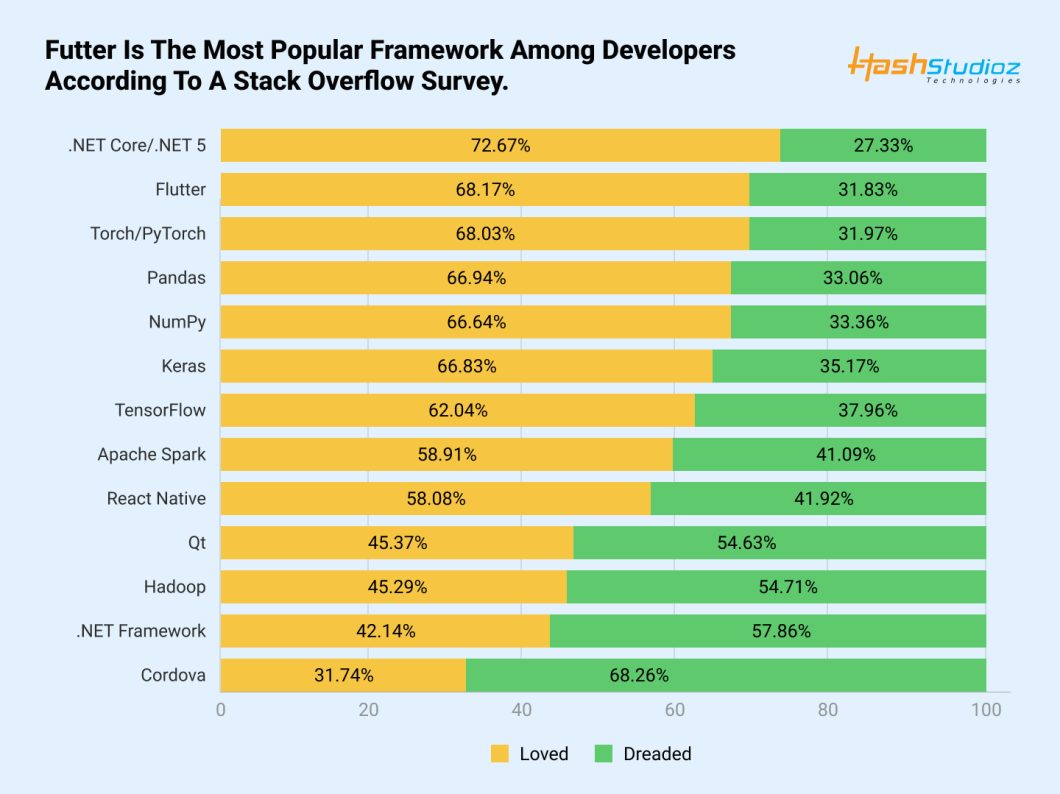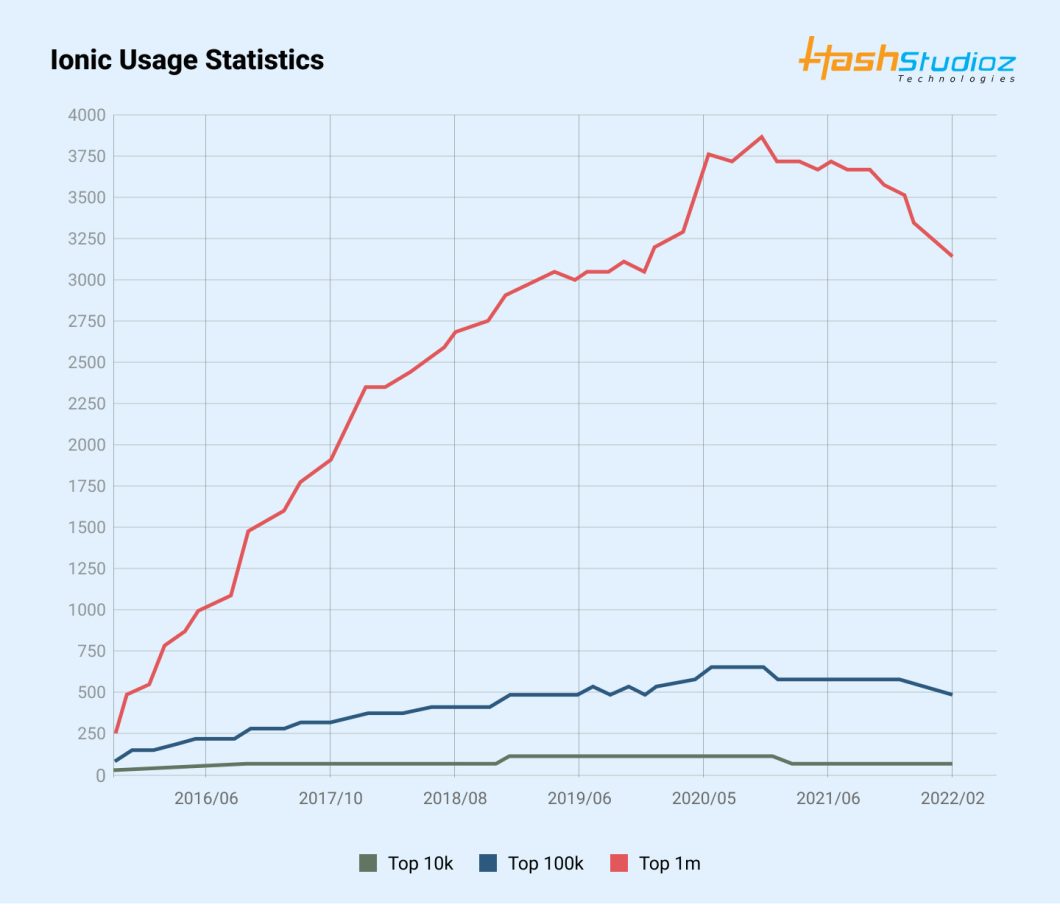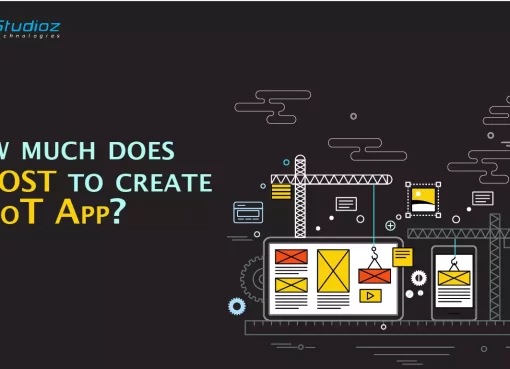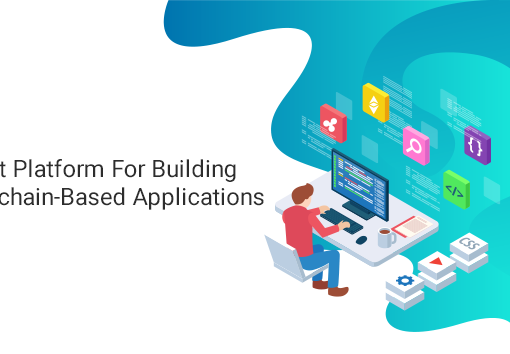Want to enhance your business by reaching a wider audience? Businesses can develop mobile apps faster when they develop cross-platform apps instead of developing apps exclusively for one platform.
With our years of experience in cross-platform app development, we have written a complete guide to cross-platform mobile app development, its frameworks, why are these frameworks beneficial, and the challenges in building cross-platform apps. It will help you launch your app more quickly. Let’s dive in.
Table of Contents
What is cross-platform mobile app development?
Cross-platform app development, or hybrid mobile app development, is an app development methodology that enables us to create an app compatible with a wide variety of platforms and operating systems.

Since they combine independent and native code, hybrid or cross-platform applications look and feel native. By writing code once and reusing it, developers can create fast and cost-effective applications.
Using cross-platform app development frameworks, you can create hybrid apps for multiple platforms (Windows, Android, iOS, etc.).
Best Cross-Platform Framework 2023
1. Flutter
This is the most popular cross-platform app framework that can be used by developers to create apps for Android and iOS without having to write separate code bases. In fact, you are able to develop web apps for browsers, Windows, and Linux using the same codebase.
Flutter is one of the most popular applications on the market. It is currently used by Google for the modules of the Google Assistant and the interface of the Google Home hub.
Flutter is not only used by Google, but also by large eCommerce companies such as eBay and Alibaba Group.
Advantages of using Flutter
- Single codebase: The Flutter framework allows developers to create feature-rich apps for Android, iOS, web, and even desktops with a single code base. As a result, you will save a great deal of time and effort.
- Faster development: On emulators, simulators, and hardware, you can see changes made to the code in real-time. It will take a second for the modified code to be loaded. It’s great for fixing bugs.
- Best performance: Both iOS and Android devices benefit from smooth performance with Flutter. This is one of the best mobile development frameworks for both native and web applications.
- In-depth documentation: The extensive documentation provided by Google makes it a developer’s favorite. Due to its well-organized, clean, and concise nature, the Flutter mobile framework is easy to implement on any OS.
- Firebase integration: With Firebase, you can build apps using Backend-as-a-Service (BaaS)-based backend services, such as real-time databases, cloud storage, static files, machine learning, etc.

2. React Native
Have you ever wondered if React Native is good for developing mobile apps? Facebook created this open-source, cross-platform framework to allow developers to create cross-platform iOS and Android apps. While the application logic is written in JavaScript, the UI is 100% native. You can avoid many compromises associated with HTML5-based UIs with React Native.
You can build cross-platform apps using the same codebase and UI components with React Native. React Native can also be used in existing Android and iOS apps or to create an entirely new cross-platform app.
Advantages of using React Native
- Code Reusability: The iOS and Android platforms reuse almost 90% of the code
- Cost Efficiency: React Native mobile app dev framework saves your development expenses by up to 40% as the code is reusable. It has a lot of pre-built components & which speeds up the app development process even more.
- UI Focused: It is possible to create both simple and complex app interfaces using the exclusive React JavaScript library.
- Live Reload: React Native’s live reload feature allows you to view and track changes in real-time.
- Native Look and Feel: There is a 1:1 ratio of native development components to react-native components. A JavaScript-based user interface combines with a native user interface to give the app a native look.

3. Xamarin
Microsoft developed the cross-platform app development framework in May 2011. A Microsoft technology stack is used to build the framework. With the most effective cross-platform app development framework, developers can share up to 90% of code across powerful platforms. With more than 1.4 million developers backing it, this framework is easy to use. Therefore, if you encounter any issues, they can be easily resolved.
The native-like interface and controls make assisting the development of native-like apps easier. Developers experience fewer runtime errors or issues with Xamarin since it provides great compile-time checking. The software also integrates with Visual Studio and creates amazing iOS, Android, and Windows apps.
Advantages of using Xamarin
- Native User Experience: With the use of Xamarin.forms, Xamarin application development results in native or near-native applications.
- Single Technology Stack: Visual Studio allows you to use the single language C# within the technology stack to develop multiple solutions without switching environments.
- Open-Source and Microsoft Support: As an open-source framework, Xamarin is constantly improving. Moreover, it is backed by the most dominant power in the world, Microsoft, which makes it scalable, stable, and robust.
4. Node.js
The Node.js platform is an open-source, cross-platform app development framework that is completely free. The development of network and server-side applications is primarily done with it. It was developed in 2009. Both start-ups and established businesses use it because of its amazing features and functionality.
Node.js is undoubtedly more powerful than PHP and Java on the server side. Video streaming sites, online chat apps, single-page apps, and more can be developed with it. JavaScript modules are available in the library, which greatly simplifies web application development.
Advantages of using Node.js
- The pool of frameworks: It provides developers with a large pool of frameworks to choose from when developing cross-platform applications.
- Easy to learn: The “JavaScript Everywhere” principle makes it easy to learn. The JavaScript programming language is among the most popular.
- Fast, easy to scale: Node.js apps are fast and easy to scale. Additionally, it has a large and active community for learning and support.
5. Ionic
Developers can build high-quality cross-platform apps using Ionics’s open-source SDK. You can build robust cross-platform applications using its mobile-optimized UI components and gestures.

Apps developed with Ionic are distributed through app stores for installation and are developed using modern web technologies like CSS and HTML.
Advantages of using Ionic
- Single codebase: Using the Ionic mobile apps framework, developers can create high-end user interfaces while developing applications for several platforms. Ionics’s programming languages enable easy & smooth switching between OS platforms, making the app platform-independent.
- UI/UX Design: A mobile application’s UX/UI design is what makes it unique and different from others. In addition to its wonderful animations, Ionic has attractive themes and designs. For the development of mobile applications, this is one of the most popular front-end frameworks
- Based on Angular.js: Ionic is an app development framework powered by Angular.js, which develops the engine that powers Ionic-based mobile applications. By using HTML syntax, AngularJS provides an excellent structure for making code more docile. High-performance browser-based apps are created with AngularJS.
- App Integration: A business can share information and processes among different apps with Ionic’s high-end application integration. Businesses can further leverage it by coordinating processes and connecting their features to cloud applications.
6. NativeScript
An open-source cross-platform framework called NativeScript is used to create programms with a native appearance and feel. NativeScript apps will behave the same as a native app designed for iOS or Android. When developing apps on platforms like Xcode or Android Studio, JavaScript is used to interact with the same native APIs. Developers can build apps faster with code reuse due to its active developer community.
Advantages of using NativeScript
- Device-specific features: By utilizing Native APIs, NativeScript lets developers build mobile apps. Therefore, even complex applications are easier to develop since they can incorporate device-specific features.
- Quickly build: By supporting many popular JavaScript libraries, developers can build quickly without the need to learn new libraries.
- Saves time & money: It allows developers to reuse code and save time and money by developing iOS and Android apps with Angular.

7. Firebase
It is a backend-as-a-service (BaaS) platform designed for developing multi-platform mobile applications. In 2011, it was founded. As of 2014, Google acquired the platform. Developers can take advantage of this cross-platform app development framework to create custom apps and increase revenue by providing them with various tools and services.
The Firebase platform is one of the best cross-platform app development frameworks available to developers worldwide. The software contains powerful features for developing, enhancing, and managing applications. Firebase has a variety of amazing features such as push messages, authentication, analytics, databases, file storage, etc. Due to the fact that these services are cloud-hosted, developers are able to perform on-demand scaling easily and efficiently.
Advantages of using Firebase
- Real-time databases: It offers real-time databases which provide developers with offline access to apps without internet connectivity.
- Easy to learn: Beginners can easily learn it since it consists of well-prepared technical documentation.
- Pre-made APIs: With just a few clicks, you can add new functionalities using pre-made APIs.
8. Sencha Touch
Developers have created countless web-based cross-platform apps using the Sencha Touch cross-platform app development framework since it was released almost a decade ago. By combining Sencha Touch with Ext JS, developers can create efficient applications that use hardware acceleration.
Advantages of using Sencha Touch
- Error-free experience: A Sencha Touch Framework application is secure and thoroughly tested. The user experience will be smooth and error-free without any underlying bugs.
- Great backend data package: Developers can work with data sources effortlessly with its excellent backend data package.
- Compatible: It maintains complete compatibility between older and newer versions of an application.
Why are cross-platform app development frameworks beneficial?
This section will help you understand how cross-platform mobile apps can help your enterprise business grow by examining the pros of cross-platform apps.
Fast app development
Developing cross-platform apps allows you to launch your application faster. You will also be faster on the market with a similar codebase, which reduces your efforts by 50 to 80%.
Assume you are building Android apps. If you intend to develop applications for mobile platforms, you will need to practice coding in Java and master the Android SDK, Android NDK, and IntelliJ IDEA. This rule also applies to iOS devices, where you will need to learn Swift.
Using a “write once, use everywhere” approach, you can develop cross-platform apps using the same code. Developers can therefore deliver cross-platform applications within the estimated app development timeline.
A wide audience reach
If you build a cross-platform app, you can launch it on various mobile app development platforms, including the web. The majority of operating systems are Android and iOS, so it’s important to create an app that targets both.
With a single app, you can target multiple platforms, such as iOS and Android. By making your products and services available on both Android and iOS, you can expand your reach and increase your revenue.
Cost-effective
‘Write once, run everywhere’ is the principle behind building a cross-platform app. Furthermore, it is expensive and difficult to develop native apps for specific platforms. Consequently, it increases app development costs.
However, with cross-platform applications, this is not the case. The development costs for cross-platform apps that run on multiple platforms can easily be cut in half. As a result, cross-platform app development is more cost-effective.
Integration with Clouds
With cross-platform apps, you can use a variety of plugins integrated with the cloud settings, as cross-platform apps are plugin-compatible.
You can enhance the quality and performance of your cross-platform app by integrating different plugins and extensions into a single source code.
Challenges in building cross-platform apps
When cross-platform app development began in 2011, it was restricted to developing basic applications for mobile devices and simple games. With the development of modern technologies, this process has become more flexible, versatile, and powerful. Cross-platform mobile app development still faces certain challenges in the following areas, however:
- Applications that integrate native and non-native components are extremely fragile. There can be compatibility and performance issues in the application due to this inconsistency in communication.
- Developing cross-platform apps for multiple devices and operating systems can be challenging for many developers. As this is one of the core features of the development process, it might affect productivity.
- Some glitches are present in the cross-platform application’s performance. The overall user experience can be adversely affected by these glitches. As a result, it leaves a negative impression on your customers.
- Data that needs to be stored by cross-platform applications is not the first choice for sensitive applications. This is because these applications have quite questionable security considerations. These applications are therefore not preferred by users for business websites like e-commerce sites.
Conclusion
Above mentioned best cross-platform frameworks have helped web development companies achieve excellence and convenience. A primary objective of these app development frameworks is to promote universal compatibility while maintaining cost efficiency. Choosing the right framework requires developers to evaluate project requirements and business requirements. It is your ultimate goal as a developer to maintain the highest level of customer satisfaction.
At HashStudioz, with our innovative mobile app development services, businesses are increasing their efficiency and their feedback has made us a top mobile app development company.





